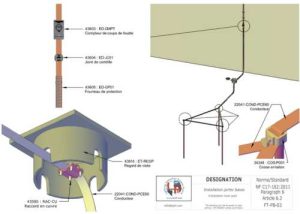The earth connection for a lightning rod plays a crucial role in the overall lightning protection system. Here are its main functions:
Lightning Energy Dissipation:
The earth connection allows the electrical energy of lightning to be safely dissipated into the ground. When a lightning rod catches a flash of lightning, it directs this massive energy to the earth through a system of conductors. The earth connection is the final element that receives this energy and spreads it into the ground.
Damage Prevention:
By directing lightning energy away from structures, grounding helps prevent physical damage to buildings, such as fire or structural damage. It also protects internal electrical and electronic systems against lightning-induced surges.
Peoples' security :
Grounding is essential for the safety of the occupants of a structure. By ensuring efficient dissipation of lightning energy, it minimizes the risk of electric shock or other lightning-related hazards to people in the building.
Compliance with Standards:
Lightning protection standards, such as NF C 17-102 in France or IEC 62305 internationally, stipulate specific requirements for earth connections. Compliance with these standards ensures that lightning protection systems comply with safety standards.
Reduction of Electromagnetic Interference:
Proper grounding helps reduce electromagnetic interference that can be generated by lightning discharge, thereby protecting sensitive equipment.
Stability of the Electrical System:
Grounding contributes to the overall stability of a structure's electrical system by providing a return path to the ground for electrical currents.
For these reasons, an effective and well-designed earth connection is an essential part of any lightning protection system, ensuring the safety and protection of structures, equipment and people from the destructive effects of lightning.






